The Top 29 Asana Alternatives In 2020 [The Ultimate Breakdown]
The best 29 Asana alternatives in 2020
![The Top 29 Asana Alternatives In 2020 [The Ultimate Breakdown]](/content/images/size/w2000/2023/11/im31.jpg)
Most people’s story about looking for Asana alternatives:
*Mouse Button Click*
1,2,3,4,5 seconds pass… still nothing.
Your MacBook Pro freezes. Unresponsive. It’s overheating, fans running at full blast.
You’re starting to worry.
“Can the motherboard endure all this heat?” — you’re asking yourself while slowly getting pissed off and exasperated.
How the heck a single external link to an Asana task can cause you so much trouble?
Tension rising up your nerves… you are trying to contain your composure and find a logical solution to your problem…
Yet, the only logical thing right now for you would be to smash your screen and just forget about this high-tense situation.
Luckily, your MacBook Pro comes back on track out of the blue. The task in the Asana app has loaded and opened successfully. Everything is running smoothly except for your mind.
You’re still frustrated and mind-boggled by the protracted unresponsiveness of Asana.
With a mind filled with anger and a flushed face, you head over to Hacker News. You find the latest news about Asana. Click on the forum thread and start typing… fingers running through the keyboard at cat’s speed. You don’t give a damn about the grammar or lexical structure of your statements. You just can’t contain your emotions. Without conducting any grammatical or lexical reviews, you ferociously hit “Comment,” nearly breaking your left mouse button.
You don’t care… whether an Asana employee will notice your horrible experience and try to fix the problem. You are already Googling your way through some of the top Asana alternatives out there, searching for an app that won’t overcome you with so much anger that you’d have no other choice except to lean against the closed door of your office and silently scream.
In this article, I’ve compiled a list of some of the best Asana alternatives to help you avoid such boiling situations. I’ll start by breaking down Asana’s features, pros and cons and then transition to Asana’s worthy competitors.
Without further ado:
Asana
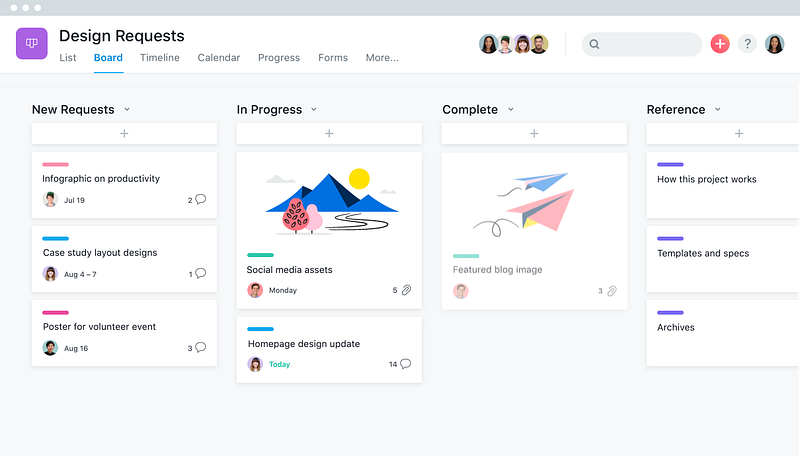
Some people love Asana because of its simple UI, tons of great features and effective project management.
Others detest it (OK, not detest… but they don’t really like it) due to its unresponsive nature. Nevertheless, Asana is great for both professional and personal use.
When the Asana app was released in 2008 by Dustin Moskovitz, one of Facebook co-founders… Asana took the project management market by storm.
Since then it has been growing big time, raising more than $200 million in funds and most lately being valued at $1.5B. There are talks about Asana going public, but time will show.
OK, so what makes Asana’s project management stand out?
First, its simplistic and intuitive interface is just outstanding. It’s a real pleasure navigating your way through Asana’s UI while managing your tasks.
Second, the array of wide-ranging features Asana brings to the table is second to none. Asana offers something for everyone… and that may actually be one of its biggest problems.
The thing with such successful companies is that they initially focus on a narrow segment in their market (which is actually awesome). The startup has a vision that perfectly aligns with that particular market segment. Users are over the moon, and the company is growing.
Yet, once the company signs up for the unicorn club (reaches a valuation of over $1B), it begins a huge expansion by adding new features that existing users may not really want. That’s because the once-a-startup company is now trying to please a much broader market to bring more users (and revenue) on board.
However, what happens is that the existing users start despising newly-added features as they add no extra value to them. And the newly signed-up customers don’t feel genuinely delighted as those extra features are made to please a big market instead of narrowing down on a specific group of customers. “One can’t hold two watermelons in one hand.” — as the Balkans say.
And people fear that Asana may actually turn into such a company.
Disappointing unicorn and startup stories aside, let’s see how deep your pocket needs to be to meet Asana’s expectations.
Asana pricing plans can vary based on your needs. You can get the forever-free Asana version and have unlimited tasks and projects + free Asana templates.
The Asana Premium Plan with tons of extra premium features starts at $13.49 per user per month. And the Business Plan starts at $30.49 per user per month.
Asana also boasts customizable pricing plans for enterprise companies. All in all, Asana can be quite costly for larger companies, but it offers some fantastic features.
Here are some of the best Asana features:
- Asana dashboards.
- Asana kanban board software.
- Asana resource management.
- To do lists.
- Asana timeline with a gantt-chart like view.
- Calendar.
- Projects.
- Tasks.
- Subtasks.
- Asana recurring tasks.
- Asana reminders.
- Asana milestones.
- Task assignees.
- Sections.
- Asana custom fields.
- Due date and times.
- Attachments.
- Asana project templates.
- Forms.
- Rules.
- Likes.
- Approvals.
- Sync tasks across projects.
- Asana task dependencies.
- Custom templates.
- Copy projects.
- Permissions.
- Asana collaboration features — task comments, chat, conversations.
- Followers.
- Asana training and tutorial videos.
- Asana status updates.
- Asana reports.
- Asana time tracking.
- Asana desktop app for Windows.
- There is an Asana app for Mac available too.
- Asana mobile — iOS app and Android app.
- Integrations with Trello & GitHub & Google Drive.
- Asana also boasts an email integration.
- And more.
What’s fascinating about Asana being a project management tool is that you can effortlessly create tasks within your beautifully-designed Asana dashboard. You can even use the drag-and-drop feature to effortlessly structure your assignments across your board. And thus allow your teammates to understand what you are working on within a glance. Copying and pasting line issues from a spreadsheet, text file, or chat feels like a breeze. You can easily edit your projects with multi-select.
Moreover, Asana boasts Trello-like boards that will definitely bring valuable insights into your team’s progress. You’ll know at a glance the next steps that need to be taken.
Why some teams love Asana is because of the transparency it can bring into their Asana workflows. You can make sure that nobody feels overwhelmed or burned out by reducing their flow of tasks whenever needed.
And finally, a lot of people prefer Asana over other tools because of its granular and robust way of managing your projects. You can create projects, tasks, subtasks, sections, and expand even further without any hassle whatsoever.
Yet, there are some downsides to Asana that are worth mentioning as well.
The biggest downside of Asana so far is its slow and unresponsive UX. As described at the beginning of this article, you can literally wait for up to 30 seconds to open Asana tasks from external links.
Loading times in Asana are as well poorly handled. All this unresponsiveness can exasperate people, especially if you are in a hurry to meet deadlines. And not only that, but it can also diminish your productivity as your anger and fury take over your rational thinking.
Another concern is the pricing plans. Even though Asana offers a free plan for up to 15 users, the paid plans have a hefty price tag, especially with extra valuable features like Gantt charts.
Although Asana empowers your team with in-task comments and convos, once the task is archived or marked as complete, it’s tough to find those convos further down the line because of Asana’s poor search engine.
Unlike Trello, Asana doesn’t allow you to switch between the board and the list view. Whatever you pick, it’s irrevocable.
And finally, Asana tends to overload your lists with tons of tasks. That means your list can get super lengthy. And structuring tasks becomes a laborious burden that decreases your productivity as well.
Here are some slighter dislikes that customers have submitted about Asana:
- “Disconnecting / reconnecting” notifications can disable the entire app for a couple of seconds.
- Adding files or emails from Outlook by using the drag-and-drop features isn’t possible.
- Sometimes you can’t preview attachments unless you reload the page.
- Cross-referencing two tickets is quite hard unless you clone the tab and open the separate tasks in both tabs.
- There’s no markdown support. You’ll have to remember bulky sets of unique hotkeys for message formatting.
- Some customers complain that Asana’s paid support and training aren’t that worth it.
- Custom fields seem to be accessible across teams in your company. However, there isn’t any easy way to move them across projects.
And finally, a couple of Asana app reviews from existing customers:
“It’s quite easy to use and it has helped me a lot to keep track of my daily tasks. But I hope it could provide more features like insights and trends in the free version.”
“There’s one thing in particular that I’ve found to be frustrating with Asana. Their customer service has been extremely hard to reach at times.”
“Asana has been a huge asset for our team. We can break client work down and keep it all orderly in one place with great updates.”
Codegiant

Codegiant is a fascinating Asana competitor that you’d definitely benefit from if you are struggling with chaotic workspaces and features spit all over the UI.
Codegiant boasts a straightforward UI that won’t make you feel like you’ve been dropped in the middle of a scorched desert desperately searching for an oasis.
Codegiant brings tons of features to the table as well. Creating, distributing and keeping track of your tasks and progress feels like a breeze. With Codegiant, you’ll have the chance to easily visualize your project workflow. You won’t have trouble seeing the direction your project is moving toward.
What’s more, Codegiant offers both intuitive Kanban and Scrum boards.
Codegiant has enough flexibility to fit your workflows, accelerate the team efforts, and make your tasks easier to digest.
Features:
- An agile project management software with a simplistic interface.
- The issue tracker features two board styles: Kanban and Scrum.
- Roadmaps.
- Sprints.
- Epics.
- Analyze your tasks’ performance.
- Tasks and subtasks.
- Tags, mentions, and comments.
- Time estimates.
- Import projects from Jira with our one-click Jira importer.
- Codegiant has a free plan for up to 5 users, then starts at $3/user a month.
Pros:
- Codegiant’s simplicity puts the tool high in the rankings among its competitors. When searching for a great project management tool, simplicity is one of the critical factors you need to consider. Simplicity means you won’t feel frustrated nor overwhelmed when deadlines are getting closer and you need to be working at full blast.
- You’ll have the opportunity to bring your team on the same page with easy-to-use collaboration tools like comments, mentions, and assignees.
- Except for its unbelievably easy-to-use Issue Tracker, Codegiant boasts Git repositories, CI/CD, and publishable documentation. These features make it the perfect option for development teams.
- And what’s even more, Codegiant’s free plan allows you to explore the tool without paying a dime. You can simply try it out and see if it works for your needs.
Cons:
- More integrations need to be added (which is something that we are currently working on).
- We also saw some users complaining about our customer support. We understand that we could have done better in the past. That’s why now, we’re hiring a full-time support team that is willing to go above and beyond when it comes to solving our customers’ problems.
“The ease of use is incredible when you come from Atlassian Jira. Everything seems straightforward and intuitive. The fact that you have everything in one place is a big plus. And the free plan is really interesting!”
TRELLO
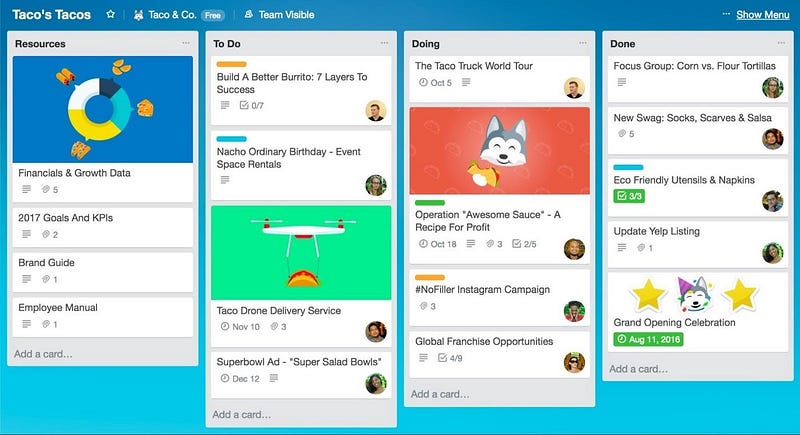
Trello is one of the best Asana competitors out there. The main thing about this app is the visibility it provides you with. You’ll be able to visualize your workflow steps ahead of time. And thus let your teammates know the tasks that need to be done first.
With Trello’s boards, cards, and lists, you’ll have the opportunity to effortlessly organize your projects in a flexible way that can easily adjust to your work methods.
Trello is suitable for both business and personal projects.
You can break down your tasks into detail by adding comments, attachments, due dates, and keeping your team on the same page.
What’s more, Trello allows you to automate tedious tasks through Butler to soar your productivity levels. You can automate rule-based triggers, custom card & board buttons, calendar commands, and due date commands.
Features:
- Create cards.
- Add comments.
- Upload file attachments.
- Checklists.
- Labels.
- Search.
- Filters.
- Due dates.
- Drag and drop.
- Discussions.
- Notifications.
- Emojis.
- Available apps for iPhone, iPad, Android phones, tablets, watches, and Kindle Fire tablets.
- Trello pricing plans at $12.50 per user per month.
Pros:
- The main aspect of Trello that makes it a favorable fan choice is that it’s lightning-fast. Adding or updating information to your boards happens almost instantly.
- Keeping your team up to date by tagging and assigning cards to your team members is easy. You can also color code different cards which allows you to visually understand what’s going on at a glance.
Cons:
- It’s hard to scale your boards. Once you assign multiple teams on the board, it gets quite hard to keep track of every task in your projects.
- Except for the free version, the Business class and Enterprise plan don’t offer free trials which makes it difficult to assess the premium features.
- The mobile app interface can be quite clunky. You can lose track of your messages and team updates.
“I find it very useful to organize all of the work within my division. It’s easy to move cards around so you can keep up with all of the work and easily see and move everything in real time.”
Notion
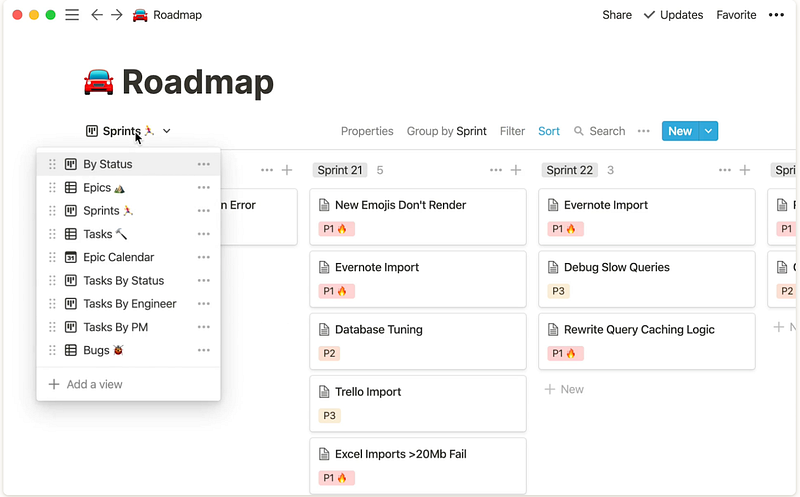
Notion is the perfect project management tool for keeping your notes, wikis, and tasks in one place. It’s super lightweight and flexible. It’s definitely one of the top Asana competitors for 2020.
Notion comes with kanban boards, tables, lists, and more. Defining and adding tags enables you to organize your information the way you want it without any hassle.
You can create beautiful and straightforward docs with more than 30 types of content.
Moreover, you can embed 50+ apps inside Notion pages and thus create a hub for everything your team is working on.
But perhaps the most essential thing that makes Notion such a huge success even though it’s only 2 years old is that it’s light, fast, and distraction-free.
Features:
- Notes & docs.
- Wikis.
- Projects and tasks.
- Kanban boards.
- Tables.
- Lists.
- iOS and Android apps.
- Clear navigation.
- Markdown.
- Slash commands.
- Drag and drop.
- Comments, mentions and assigns.
- Discussion.
- Real-time editor.
Pros:
- If you need to keep your personal and business life organized without using multiple apps, Notion is definitely your salvation. With both desktop and mobile versions, Notion takes care of your project management from end to end. Some people even think that Notion should be charging more for the value it provides.
- What’s more, the tool is hyper-flexible, allowing you to easily adjust it to your work methods.
- Because of its intuitive design, getting started with Notion can be as easy as ABC.
Cons:
- Some users (advocates of visual thinking and organizing) would prefer having a top-to-bottom kanban board versus a left-to-right one and options to color code calendar events, add tables in spreadsheets, and cards in the kanban view.
“I get more excited every day with Notion. Not only is it an amazing platform for life organization, but their people and community are lovely and empowering.”
Airtable
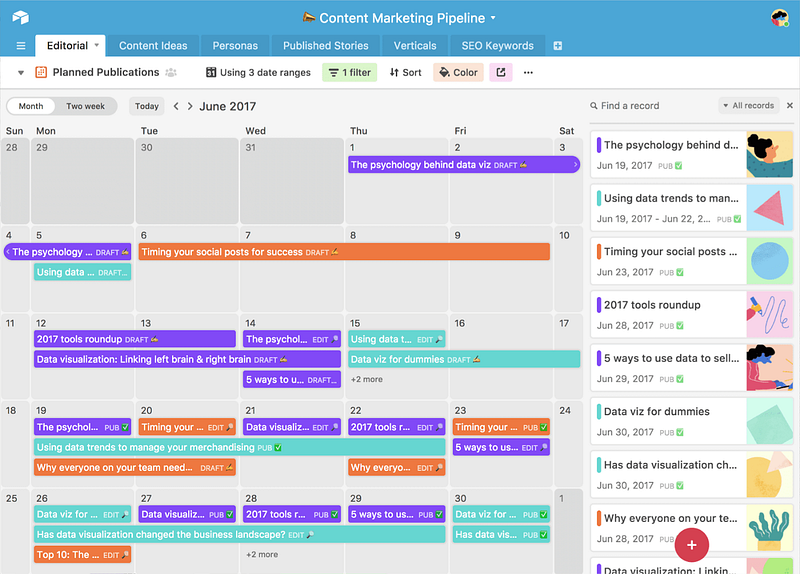
Airtable is another fantastic task manager alternative to Asana. It’s a half spreadsheet and a half database tool. The outstanding thing about Airtable is that it’s super flexible, allowing you to organize your work projects the way you like it.
Airtable offers Kanban, calendar, grid, and form views for your projects to stay organized. And what’s more, you can immediately hit the ground running by accessing the built-in templates inside Airtable made by industry experts.
Airtable comes with native mobile and desktop apps that allow you to edit, comment, and collaborate in real-time without any hurdles along the way. You can sync with your team and overcome any obstacles that come along.
Features:
- Add attachments.
- Long text notes.
- Checkboxes.
- Links to records in other tables (barcodes).
- Desktop and mobile apps.
- Filtering, sorting, grouping.
- Save and share views.
- Tons of integrations.
- Calendar management.
- Customized views.
- Customized tables.
- Automatic back up.
- Templates.
- Tags and keywords.
Pros:
- Airtable is one of the best task manager alternatives to Asana. It helps you keep your professional and personal life strictly organized. You’ll have the chance to clearly see what’s the next step you need to take and thus ensure no frustration hampers your way.
- Airtable is incredibly easy to use. You won’t be driven up to the wall like you are used to with other sophisticated project management tools.
- Airtable also integrates with other great tools so you can have all of your favorite tools synced, making your life easier.
Cons:
- Getting onboard can be a bit tricky as Airtable doesn’t have any introduction tutorials.
- The free plan of Airtable is quite restrictive in terms of features. The features that make Airtable outstanding can be found in higher-paid plans.
- The mobile application is not as robust as the desktop software. Although the mobile app comes with the major features, it’s still missing other cool features like forms, which can be kinda disappointing.
“Airtable is a phenomenal system for handling large tasks in teams, the service is undoubtedly very powerful, offers a very manageable cost for small organizations and offers a completely intuitive interface so that anyone can integrate to use the service without any problems.”
Basecamp
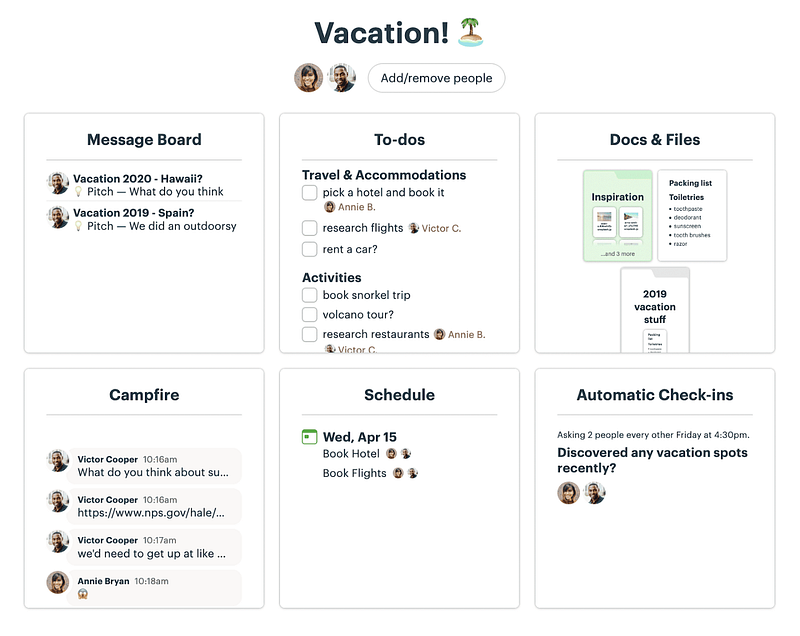
Basecamp is a thrilling app like Asana and perhaps one of the best project management tools out there, period. It markets itself as the all-in-one toolkit for working remotely. Basecamp can be one of the most valuable tools you can use in such tough times.
Basecamp is built with fantastic features such as messages, boards, to-dos, group chat, schedules, automatic check-ins, docs, files, and tons more.
The cool thing about Basecamp is that it allows you to break down your projects into details. And thus clearly see the tasks you need to complete first to finish every project successfully and on time.
Adding discussions and commenting is made effortless to bring your team on the same page and overcome any hurdles along the way.
With message boards, you can bring your conversations on a single page and avoid digging through emails trying to bring old stories to life from fragmented replies.
What’s more, with Basecamp, you can stop wasting time on status meetings and use automated check-ins instead. And thus let your team ask and answer questions regularly in one easy-to-digest thread.
Features:
- To-do lists.
- Add notes and file attachments.
- Comment directly on tasks and lists.
- Track work progress with Basecamp Hill Charts.
- Message boards.
- Embed images and files.
- Add events with dates, times, and date ranges.
- Notifications.
- Link Google Docs.
- Drag and drop upload.
- Reorder and color code files.
- Assign tasks.
- Due dates.
- Schedules.
- Share documents, files, and images.
- Real-time group chat.
- Direct messages (Pings).
- Mentions.
- Attach files, quotes, and code samples.
- Keep everything private until you choose to share.
- Reports.
- Automatic check-ins.
Pros:
- Basecamp boasts everything you can ask for from a project management tool. It also has an outstanding support team that will go above and beyond to solve your issues.
- One of the main differences that allow Basecamp to top its competitors’ rankings is the affordable pricing plans it brings to the table.
- The user interface can be customized altogether based on the work methods you use. You can adjust Basecamp the way you like it so you can feel comfortable working with it.
Cons:
- Because it offers tons of incredible features, it can be hard to navigate through the interface, especially if you are just starting out with Basecamp. Even though you can use guides and cheat sheets, it’ll still take time to fully grasp the way Basecamp operates.
- Gathering different teams in Basecamp can be hard as you only have one message board and chat.
“Time management and productivity. Makes my job easier rather than having to constantly ask for progress updates.”
Smartsheet
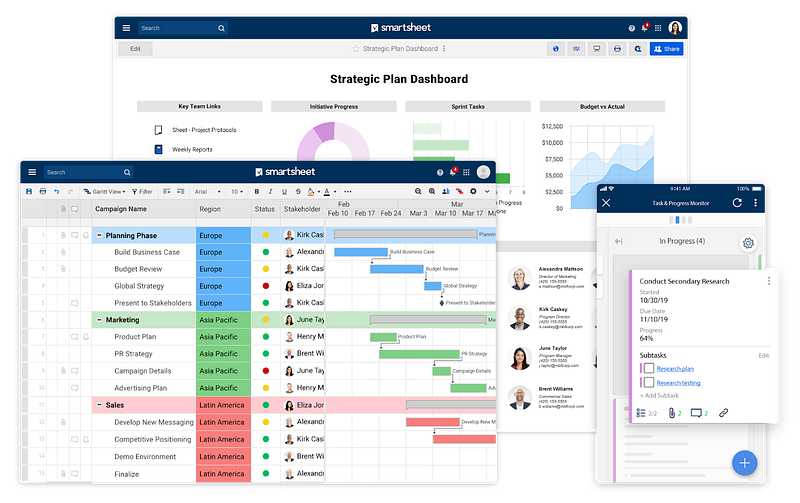
If you are looking for a spreadsheet-like Asana alternative, then you can’t go wrong with Smartsheet. This Asana competitor allows you to dynamically plan, execute, and report on work to move faster, drive innovation, and get more done in less time.
Smartsheet is a super flexible tool that doesn’t require you to have technical expertise to manage your way through it. You can adjust it to your workflow easily and thus accelerate your production efforts.
What’s more, you can automate tedious tasks such as sending alerts, requesting approvals and updates.
Smartsheet gives you a granular look into your projects so you can explicitly see the next steps that need to be taken care of.
Features:
- Easy-to-use widgets.
- Data charts and key metrics.
- Seamlessly integrates with G Suite, Microsoft Office 365, Adobe Creative Cloud, Box, DocuSign, Slack, Workplace Chat, Microsoft Teams, Google’s Hangouts Chat, Skype for Business, Gmail, Outlook, and many others.
- Mobile apps for Android and iOS.
- Grid, Gantt, card, and calendar views.
- Attach files to Smartsheet from Google Drive, OneDrive, Dropbox, and other tools.
- Dashboards.
- Reminders.
- Forms.
- Activity log.
- Cell linking.
- Reports.
- API.
- Update requests.
- Sharing.
- Filters.
- Custom branding.
Pros:
- Smartsheet’s customer support definitely deserves lots of credit. The team behind Smartsheet will go that extra mile to ensure they meet your expectations and solve any concurrent problems.
- Some users describe Smartsheet as using a spreadsheet with many built-in project management features such as nesting tasks, RAG status, date duration, start dates, and more. The main thing that makes Smartsheet stand out from its competitors is that it’s effortless to use.
Cons:
- Smartsheet feels quite limited in terms of calculations. It is nowhere near as robust as Excel when it comes to data computing.
- Also, the user interface is not very appealing, and formatting options are limited. Onboarding can be quite cumbersome at the beginning. You may also need extra training for handling advanced tasks on Smartsheet.
“Smartsheet is a simple yet powerful project management tool that helps analysts track, share and analyze the project details.”
Jira
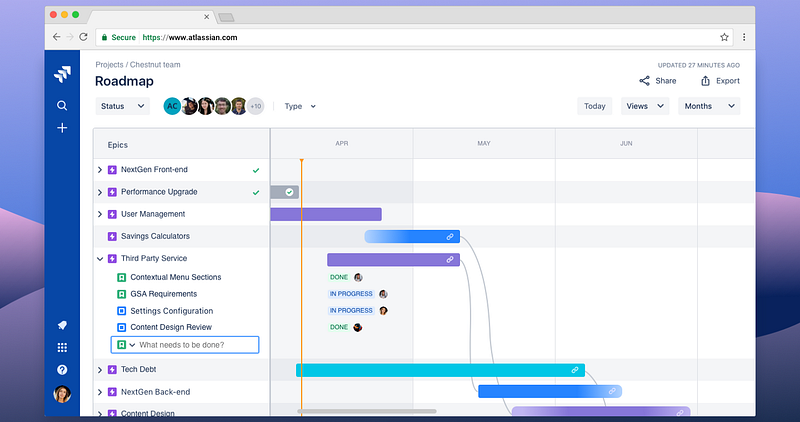
Jira is perhaps the most popular issue tracker amongst developers. Because of its initial bug-tracking design, it’s perfectly suitable for developers and not as much as for other teams like marketing and sales. Nevertheless, if you are working in a dev team, this can be the Asana alternative that will make perfect sense.
Jira enables you to create tasks accompanied by detailed descriptions and robust reports. You can also spread assignments across your team relatively easily. What’s more, roadmaps is perhaps one of the most valued Jira features as it allows you to clearly see the direction your project is moving towards.
Jira’s wide-ranging features, such as customizable workflows, robust reporting, and effective kanban and scrum boards, will help you bring your team on the same page. You’ll have the chance to hit your milestones much quicker than if you were working with outdated spreadsheets driving you up the wall.
Used by 65,000 teams, Jira has all the features your dev team will ever need to overcome any hurdles along the way.
Jira is available in three versions — Jira Align, Jira Core, and Jira Software. It also has Jira Mobile. Jira Align is mainly suited for enterprises, whereas Jira Core and Jira Software fit smaller businesses better.
Features:
- Customizable Jira workflows.
- Unlimited custom fields.
- Bugs and defect management.
- Jira swimlanes.
- Seamless source and issue integration.
- Search and filtering.
- User mentions.
- Multiple assignees.
- Project planning.
- Jira task management.
- Jira resource management.
- Jira resource planning.
- Advanced reporting.
- Customizable Jira boards and wallboards.
- Jira Kanban, Scrum and Scrumban boards.
- Advanced security and administration.
- Integration with flexible REST APIs.
- Jira hosting.
- The Jira support team is great.
- Easily import data from other systems.
- Mobile interface available for both Android and iOS users.
- OnDemand and OnPremise deployment.
- Jira supports the following platforms: Microsoft Windows, Linux, Mac OS X, Amazon Web Services (AWS), Microsoft Azure.
- Jira is free for students if you have the Atlassian Classroom License.
- Free for open-source projects and for teams with up to 10 users.
Pros:
- Jira is the perfect Asana alternative for development teams. It boasts tons of fantastic features.
- It’s one of the most popular and reliable tools out there — been on the market since 2002.
- Moreover, Jira integrates seamlessly with tons of other great tools to make your work life simpler and more enjoyable.
Cons:
- Because of its initial bug-tracking design, Jira may not be the best alternative for non-tech folks. The reason for that is because you’ll have a difficult time getting on board if you don’t have a technical background.
- The UI of Jira can also be quite hard to grasp. An array of features is thrown at you right off the bat, which may get you frustrated while trying to navigate your way throughJira.
“JIRA is one of the best organizing tools that has inter linked our various departments. And it has facilitated the transparent processing of events that was taking place in various departments.”
ClickUp

ClickUp is another worthy alternative to Asana. ClickUp markets itself as the one tool to rule them all. It definitely makes a good point here as the platform boasts an enormous amount of features… as well as an intuitive interface — something you can rarely see in a tool with tons of features. ClickUp recently raised $35 million in Series A, and it’s riding on a steady wave of growth.
With ClickUp, you can manage your projects through notes, digital scratchpads, reminders, calendars, and other beautifully-designed features.
ClickUp comes with an importer allowing you to export all of your projects from other tools (regardless of the app you are using) and directly transfer them over to ClickUp.
Some other amazing ClickUp features that will make your life easier include slash commands, real-time chat, task tray, comment assignments, and more than 1,000+ integrations with your favorite tools.
Features:
- To-do lists.
- Docs & notes.
- Spreadsheets.
- Email & chat.
- Events.
- Reminders.
- Goal tracking.
- Time tracking.
- Screenshots & recording.
- Resource management.
- You can create epics and use story points.
- Analyze your sprints’ performance.
- Use tags.
- Templates and custom statuses for process management.
- Multiple assignees.
- Boards, Lists, Gantt, and Calendar views.
- Time estimates.
- Start and due dates.
- Free plan. If you want to get the premium features, it’s $9 per month.
Pros:
- ClickUp delivers every feature your team will ever need to manage its projects effectively and effortlessly. Moreover, you’ll have access to fantastic collaboration features to boost your productivity.
- One of ClickUp’s most significant advantages is that it offers a free plan with unlimited users. You don’t even have to risk a penny.
- Boasting over 1,000+ integrations, ClickUp has the potential to truly ease your work life.
- The support team of ClickUp is merely outstanding. From the beginning, you’ll be gratefully welcomed and explained everything you need to know to get started with ClickUp.
- The cost of ClickUp is also quite flexible and reasonable for teams of any size.
Cons:
- You may need to allocate some time to fully grasp how ClickUp works.
- ClickUp doesn’t allow you to export your projects to other tools. So you’ll have to be nearly 100% certain that you are staying with ClickUp for a while when signing up.
“I’m a big fan of how organized a task can become. It’s easy to sort, organize, and assign tasks and subtasks to different teams and members of each team to keep projects flowing without being forgotten about.”
Quire
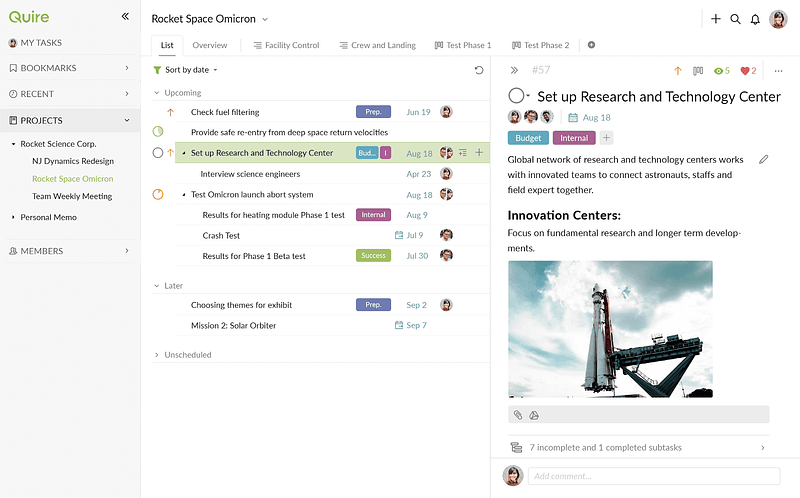
“Back in 2014, a group of developers had been trying out hundreds of project management software solutions in order to solve the productivity puzzle but left unanswered. The main problem with common project management software is that it involves a very long list, which can backfire on the efficiency in the workplace. Unwilling to settle for all the complexity, Quire was born as an answer to conquering a big project and achieving your dreams.” — Tom Yeh, CEO at Quire.
Quire can be one of the best Asana alternatives, if you are looking for a collaborative platform that can bring your team on the same page and enhance your work methods.
With Quire, you’ll have the chance to map out your thoughts onto Quire’s intuitive boards to know how to get started swiftly without any hassle.
Quire enables you to visualize your workflow so that you can easily arrange, prioritize, and focus on tasks that move the needle. You’ll have the opportunity to break down your bigger tasks into smaller chunks and knock out one at a time for better efficiency.
Features:
- Nested Task List.
- Kanban board.
- Sublist.
- Sort tasks.
- Filter tasks.
- Search.
- Health stats.
- Recurring tasks.
- Time and duration.
- Reminders.
- Notifications.
- Roles and permissions.
- Invite your clients to your boards.
- Make your projects public.
- Assign tasks.
- Zoom in.
- Health stats.
- File sharing.
- Themes.
- Export.
- Import.
- Color & styles for tasks.
- And more.
Pros:
- The uniqueness of Quire stems from the bundle of features it offers alongside its simplistic interface. You’ll rarely feel like you’ve been dropped in the middle of an intergalactic Star Wars battle without any safe shuttles near you.
- Quire’s fantastic Kanban boards allow you to clearly visualize your work, effectively communicate with your teammates and thus always meet your deadlines.
Cons:
- The mobile can be kinda limited in terms of features and customization.
- Quire doesn’t offer any templates. You may have a hard time grinding everything on your own from the beginning.
- The interface feels a bit clunky.
“Quire is a great project management software and is thorough while remaining simple and clean. It’s user-friendly and offers multiple ways to view your current tasks, which is helpful when team members all prefer different ways of tracking their tasks (i.e. list view, board view, etc.).”
SmartTask
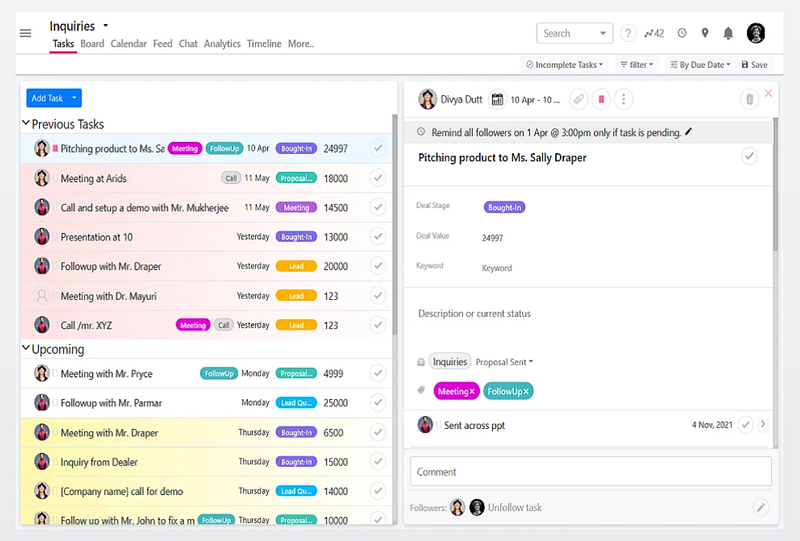
If you are looking for an Asana alternative that keeps all of your team-related information in one place, SmartTask is the best option.
The primary purpose of SmartTask is to enhance your team collaboration. It also strives to educate your team members on their assigned tasks to help you move your projects a few steps closer to the goal line.
SmartTask simply makes it easy for you to access information without getting overwhelmed by unintuitive spreadsheets and cluttered project management tools.
Moreover, SmartTask is available on mobile devices allowing you to access your workflow anywhere — at home, at work, on a vacation, or whatever.
With task comments inside SmartTask, you’ll have the chance to keep your team up to date with the latest information on the project.
Features:
- Customize tasks.
- Project milestones.
- Track projects with ease.
- Manage tasks.
- Time & budget tracking.
- Groups and projects.
- Instant messaging.
- Search.
- Attachments.
- Powerful recurring tasks.
- Project templates.
- Email reminders.
- Location tracking.
- Timeline.
- Time tracking.
- Guest users.
- Tags.
- Dates and time.
- Notifications.
- And more.
Pros:
- You can easily create tasks inside SmartTask and sort them by priority, due date, project and assignee.
- The team collaboration inside SmartTask is on a whole new level. Everybody is on the same page and there aren’t any misunderstandings between team members.
- SmartTask smoothly integrates with Dropbox, Mailchimp, Google Calendar making your life easier while at the same time enhancing your work efforts.
Cons:
- SmartTask requires you to have access 24/7 to the Internet. Otherwise, you can’t work on your projects as it doesn’t sustain an offline mode.
“We tried probably a half a dozen different tools for project management and SmartTask is where we landed. I don’t see us switching again anytime soon!”
TickTick
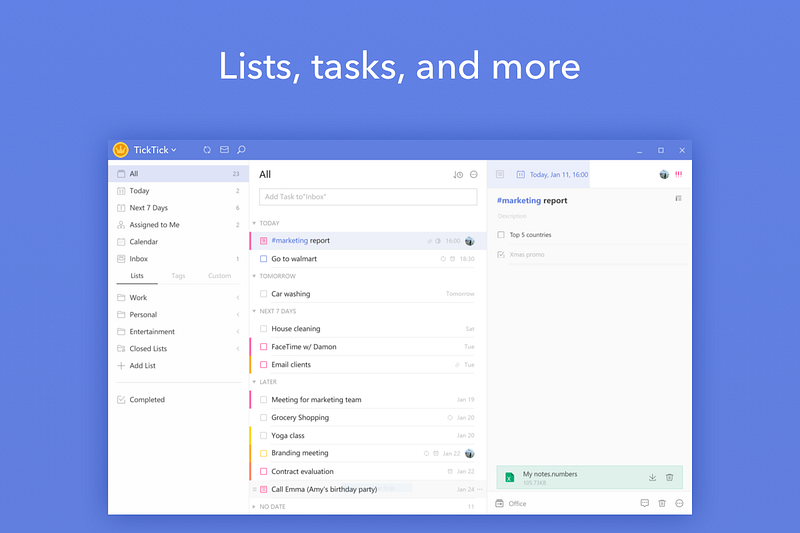
TickTick is another widely used and free alternative to Asana. It helps you note your ideas down and organize your work life to come up with creative ideas every day. TickTick boasts millions of users.
What’s cool, TickTick is suitable for both your personal and professional projects. To-dos will help you to easily manage all your projects.
You can also set reminders to put your mind at peace instead of stressing about missing deadlines.
Moreover, TickTick provides your team with 5 different calendar views to find the one that works most conveniently for you.
TickTick also makes your team collaboration effortless and effective. You’ll be able to share lists and assign tasks on the go without any hassle. And thus soar your productivity levels.
Features:
- Voice input.
- Turn emails into tasks.
- To-dos.
- Siri, widgets and Quick Ball.
- Date parsing.
- Task duration.
- Multiple reminders.
- Recurring tasks.
- Folders.
- Lists.
- Tasks.
- Subtasks.
- Custom smart lists.
- Multi-priority.
- Sorting.
- Search.
- Various calendar views.
- Share lists.
- Assign tasks.
- Task activities.
- List activities.
Pros:
- The best thing about TickTick is its free version that comes with great features such as adding descriptions, setting reminders, ordering to-dos, and sharing lists.
- TickTick is also quite robust in regards to features and flexibility. You can break down each task by priority and add notes to each one easily.
- TickTick is incredibly easy to use. Browsing through the mobile app feels like a breeze.
Cons:
- The free version can be kinda limited as it restricts your list access to 9 lists.
- Statistics and reports can be made more robust by providing more accurate details.
- Some users would also like to see more integrations.
“I don’t think I’d be nearly as productive without actually writing things down on TickTick.”
ZenTao
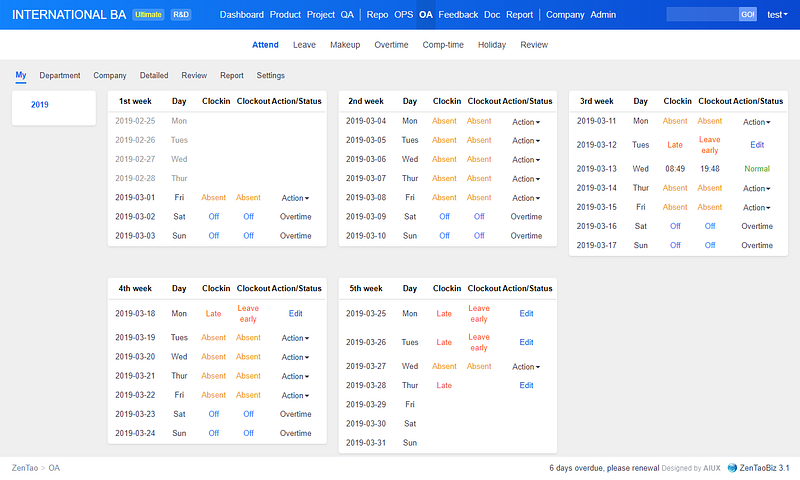
ZenTao is an open-source Application Lifecycle Management (ALM) tool. It’s another fantastic alternative to Asana.
It boasts features like product management, project management, test management, document management, bug tracking, CI management and more.
As ZenTao’s initial design relies on Scrum, you’d definitely find this tool more than useful if your team generally utilizes Scrum practices.
The uniqueness of ZenTao stems from the visibility it brings to your workflow. You’ll have the chance to clearly see the tasks ahead of you and make accurate decisions moving forward.
ZenTao offers three versions of the software — Standard, Professional, Enterprise.
With ZenTao, you can create, preview, and edit your docs easily.
Features:
- Individual work management.
- Feedback management.
- Docs.
- Product management.
- Project management.
- Test management.
- Bug tracking.
- CI management.
- Relies on Scrum.
- To-dos.
- Work logs.
- Convert feedback to stories.
- Zero downtime upgrades.
- Integrate Git and SVN.
- Word and Excel import & export.
- Flexible module combination.
- Easy customization.
- Frequent releases.
- Quick and powerful support.
- Robust extensions and various plugins.
- Roadmaps.
- Launch plan/steps.
- Link to story/task/bug.
- Simple and understandable UI.
Pros:
- What’s great about ZenTao is that it is designed with a simple and intuitive interface that doesn’t drive you up the wall.
- With ZenTao, you’ll have the opportunity to granularly break down your projects and explicitly see the next steps you need to take.
- Getting on board is also quite effortless. You don’t need any prior tech experience.
- ZenTao also comes with a free plan allowing you to test the tool without risking a penny.
Cons:
- Even though it has quite an intuitive interface, some features can be hidden in submenus and hard to discover.
- Some users have complained about minor bugs. Others would want to see more robust documentation features as they feel quite limited in terms of customization.
“End to end visibility, ZenTao will fully fill your company needs and manage all your delayed tasks so perfectly. It has come up with free to paid plans, and the paid plans are also very reasonable which we still haven’t found in any other management tools.”
Workzone
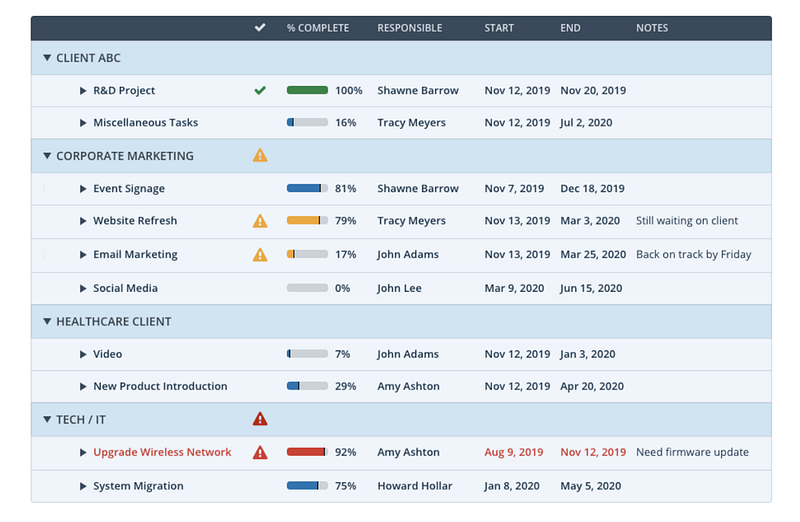
Workzone combines robustness and simplicity in one single platform where you can easily manage your business projects.
With Workzone, you can see what’s on track, what’s falling behind, and what every team member is working on.
Workzone also empowers you with a 50,000-foot view of your projects. You can clearly see the direction your project is moving toward. Moreover, you can drill down on the task’s details to define the essential steps that need to be completed first.
Features:
- Project Dashboard.
- To-Do Lists.
- Gantt Chart.
- Status Alerts.
- Project Templates.
- Task Dependencies.
- Project Request Forms.
- Workload Reports.
- Time Tracking.
- Group Calendar.
- Secure File Sharing.
- Image Markup.
- Email Alerts.
- Discussions.
- Approvals Workflow.
- File Versioning.
- Custom Branding.
- Security.
- Unlimited Support.
- API & Integrations.
Pros:
- The mobile and desktop version of the app work flawlessly — bugs may occur once in a blue moon.
- Workzone is effortless to work with. You can upload files, reassign tasks, view current workflows and tag teammates quite easily.
- And their customer support is simply outstanding. They are willing to get out of their way to help you solve your problems.
Cons:
- Reassigning tasks to new team members that are outside of the project can be difficult.
- Filtering your projects down is quite hard, and it can also be annoying.
“Workzone is a great project management software for collaboration among teams. It is robust and easy to use. It works well for decentralized teams as it is cloud-hosted.”
Nutcache
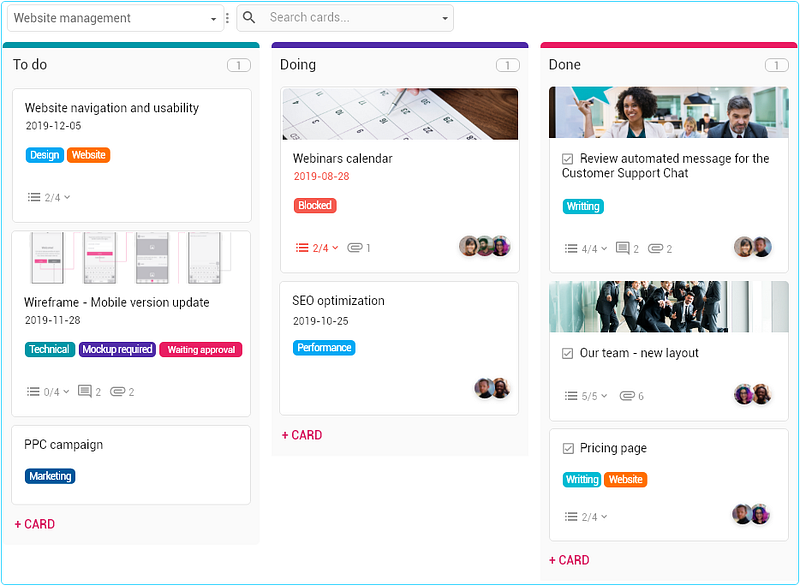
Nutcache is a fantastic Asana alternative for planning, tracking, and organizing your tasks efficiently so that you can meet any deadline without much hassle.
It’s trusted by 130,000+ businesses which actually adds a lot of credibility to it.
With Nutcache, you can see the state of your projects at a glance. You can also prioritize and group assignments either by due date or project. And thus soar your productivity levels.
Moreover, Nutcache comes with Gantt charts helping you plan, track and visually organize your tasks in the most effective way possible.
Nutcache enables you to break down tasks to see the small steps that first need to be completed.
Once you sign up for Nutcache, you’ll have the chance to explicitly visualize your workflow so you can stay aligned with your deadlines.
Features:
- Project budgeting.
- Cost management.
- Notifications.
- Set budget tracking by the hour, amount or cost.
- Define budget alerts.
- Use KPIs to stay within budget.
- Avoid budget overrun.
- Discussions.
- Upload files.
- Share files with everyone involved in the project.
- All-in-one.
- Prioritize tasks.
- Adjustments.
- Use custom workflows.
- Divide work in manageable chunks.
- Assign multiple assignees to a task.
- Gantt charts.
Pros:
- Nutcache is an all-in-one solution that boasts tons of fantastic features. Signing up for Nutcache means that you’ll no longer have to use 3rd party tools to efficiently manage your projects.
- Organizing your workflow and collaborating with your teammates happens effortlessly inside Nutcache.
- Budgeting your projects and setting alerts to avoid cost overruns will enormously help you in making more accurate cost estimates for future projects.
Cons:
- Financial and project-related reports aren’t robust enough.
- Due to its vast amount of features, the user interface can seem quite overwhelming, especially if you are trying Nutcache for the first time.
“I’ve been using Nutcache for a few years now and I must say I’m really impressed by the product. The people behind Nutcache are sure hard workers considering the amount of new features they constantly keep adding to the product.”
MeisterTask
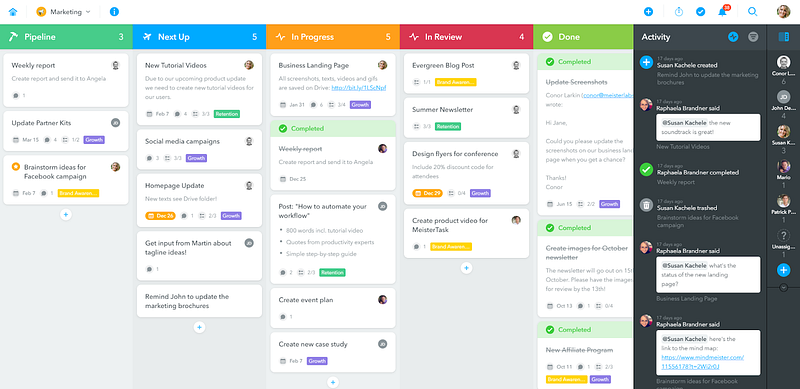
MeisterTask is perhaps one of the simplest and easiest to use Asana alternatives on this list. It’s beautifully designed and it can be effortlessly adjusted to fit your work methods. You’ll rarely have difficulties navigating your way through MeisterTask.
It relies on Kanban-style project boards to streamline and automate your workflow so that you can get more done in less time.
Using MeisterTask is like shooting fish in a barrel. If you are currently struggling with other clunky and sophisticated tools, you should definitely consider switching over to MeisterTask.
Unlike many other tools that sacrifice an intuitive UI for tons of unnecessary features, MeisterTask achieves a balance between features and a simple UI. You won’t feel overwhelmed by chaotic workspaces and at the same time have every feature your team needs to thrive.
With MeisterTask’s intuitive Kanban boards, you’ll gain a bird’s-eye view over your projects to clearly see the direction they are moving towards. Managing your tasks and team through MeisterTask’s kanban boards is super easy.
Collaboration with your teammates inside MeisterTask is made to be effortless and effective. You can get insights into your team’s productivity through robust statistics and reports.
Features:
- Kanban board views.
- Notifications.
- Statistics and reports.
- It is web-based — no downloading or manual updating.
- Mobile app for Android and iOS.
- Task relationships.
- Automations.
- Multiple checklists.
- Recurring tasks.
- Time tracking.
- Importer from Asana, Trello, Wunderlist.
- Integrations.
- Full API use.
- Statistics and reports.
- Roles and permissions.
- Group sharing.
- Security restrictions.
- WIP limits.
- Custom fields.
- Custom project icons.
- Email support.
Pros:
- MeisterTask is one of the most intuitive apps that enables you to effortlessly manage your projects without any headaches.
- Conducting group discussions and messaging happens without any hassle in MeisterTask’s reliable inbox.
- MeisterTask’s kanban boards feature is the essential pillar for putting your team’s productivity at full blast.
Cons:
- You can get a free trial; however, the plan is quite limited. To completely tap into MeisterTask’s potential you’ll have to purchase the higher-tier plans.
- Some customers have complained about various bugs such as — “the comments did not save on the mobile app, desktop app was as slow as living Internet Explorer meme” — still minor but annoying issues.
“MeisterTask helps me juggle all the ideas I have for my production. I used to get distracted with new ideas, and bounce back and forth trying to implement everything at once, but never really finishing anything completely. Now I can focus on one task at a time.”
Wrike
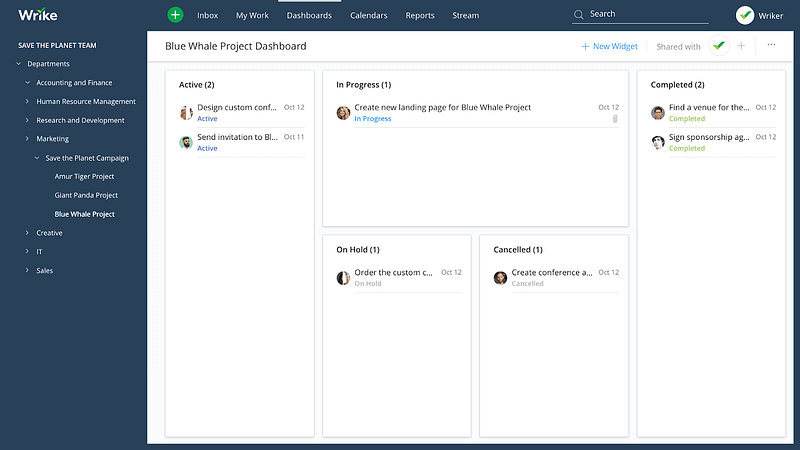
Wrike is a great alternative to Asana. It provides you with 360° visibility allowing you to clearly see the tasks ahead of you and the progress being made.
The great thing about Wrike is that it can be easily customized to fit your workflow. Wrike offers custom dashboards and various automations to streamline your workflow.
With Wrike, you can drill down on tasks and see the tiny steps necessary to move the needle.
Wrike can simplify your workflow significantly by eliminating endless email threads, needless meetings, and copious check-ins with innovative comments, notifications, live editing, dynamic reports and statistics, and more. It’ll definitely save you tons of time and thus increase your productivity.
Wrike sends you real-time updates so you can anticipate potential hurdles and prevent them from happening.
Moreover, Wrike’s enterprise-grade security is unparalleled, allowing you to put your mind at peace. It also gives you full control over your data.
Features:
- Dynamic reports and analytics.
- Tons of integrations.
- Enterprise-grade security.
- Gantt charts.
- Real-time collaboration tools.
- Instant updates.
- Personalize your dashboard.
- Made for any project management method. Whether you are an Agile or Waterfall fan, Wrike can be adjusted to fit your needs.
Pros:
- The best thing about Wrike is that it’s highly flexible and can fit into your workflow easily, so you won’t have any difficulties when utilizing it fully.
- Moreover, Wrike lets you monitor your projects over time so you can reassess your work methods and make adjustments if needed.
- Due to its simplistic design and UX, you can create tasks and subtasks and assign them to your teammates relatively easily.
Cons:
- Uploading files can sometimes be a tedious and lengthy process that can definitely drive you up the wall.
- Dashboards and reports can be improved further.
- Request forms don’t auto-populate data fields. Some automation can be added.
“Having a single source of truth for information and communication makes it easy for leadership to stay in the loop or get a new team member up to speed quickly. It mitigates the risk of tasks falling through the cracks.”
Monday
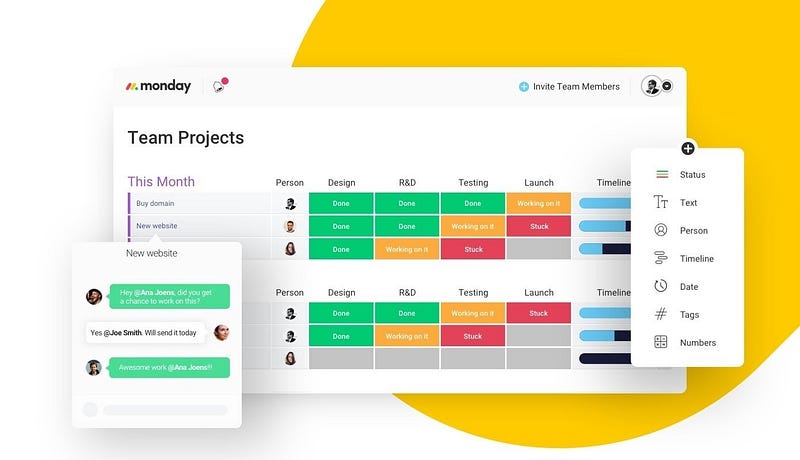
“Monday helps teams see *everything* that’s going on with a project at a high level view, so you can feel like you’re participating in a bigger picture goal, and not just a cog in a machine.” — Matt Burns, startup ecosystem lead at Monday.
Monday, one of the best project management tools out there, is a colossal Asana competitor. The tool is super flexible and easily adjusts to your workflow.
Monday allows you to automate tedious and repetitive work so you can focus on what moves the needle. It offers heaps of incredible features that enable your team to collaborate in one shared workspace.
Moreover, Monday can provide you with a bird’s-eye view over your projects, so you clearly know what step you need to take next.
What’s cool about Monday is that teams of any size, industry, or department can use it as it’s super flexible and robust. Whether you are a lone wolf or moving along with the pack, Monday is a great project management tool.
Features:
- Dashboards.
- Customizable table for managing your projects.
- Code-free automation to your boards.
- Display data in digestible ways.
- Insights into your projects, teams, and processes.
- Charts.
- More than 50 integrations.
- Forms.
- Calendar view.
- Timeline view.
- Kanban view.
- Notifications.
- Workload.
- Subitems (in beta).
- Updates.
- Map view.
- Guests permissions.
- File sharing.
- Time tracking.
- Workspaces.
Pros:
- Monday is super easy to learn and use. You won’t have difficulties navigating your way through it or managing your projects inside it.
- Monday offers robust customization to almost everything. You can easily fit it into your workflow. No hassle, no dread.
- Automations are priceless. You’ll no longer need to spend time on tedious tasks that drain productivity out of you. Instead, you can focus on the tasks that move your projects closer to the goal line.
- Whether you are a small team of 5 people or a huge enterprise, Monday can fit your needs and adjust accordingly.
Cons:
- Even though that’s not mandatory, a lot of users would like to see a dark mode.
- The search engine inside Monday’s boards seems not to be searching through group names.
“With monday.com, we’re able to work in a way that suits our needs while still keeping remote teams closely aligned and highly empowered.”
Scoro

Scoro is the ultimate all-in-one alternative to Asana. If you’d like to stop using any 3rd party apps that instead of helping you manage your projects smoothly, they punch your productivity until it hits rock bottom, then you should definitely check out Scoro.
With Scoro, you can compile reports on your projects, profitability, team utilization, and more. You can thus make more accurate time and cost estimates for future projects. And what’s more, everything in Scoro is easily accessible within a single click.
Scoro allows you to manage your time efficiently by using time management tools like team calendars, shared tasks, timesheets, automated time tracking and planning. You’ll be able to easily manage your teammates’ time.
Moreover, Scoro can give your team the clarity it needs to put away any misperceptions that may be present in your workflow.
With Scoro, you’ll have the chance to track your team’s work down to the detail to avoid work errors slipping through the cracks.
Scoro boasts integrations with over 1,000+ apps allowing you to integrate it with your favorite tools to make your work life significantly easier.
Features:
- All in one place.
- Manage your entire project portfolio.
- Customizable views.
- Project timelines.
- Prioritize assignments.
- Plan your team’s schedule weeks in advance.
- Drag and drop planner.
- Track your progress.
- Track project profitability in real-time.
- Compare project budgets to actual results.
- Automations — billing, routine tasks, and make accurate forecasts with scheduled, prepayment and recurring invoices.
- Project’s health status.
- Integrations with thousands of applications through Zapier.
- Full API use.
- Reports.
- Calendar, task lists, timesheets, built-in time tracker.
- Kanban task board.
- Monitor billable and non-billable hours.
- Task matrix to plan and stay up to date on team-wide priorities and goals.
- 360-degree overview of each customer on one page — contact details, communication history, projects, files, quotes, invoices, etc.
- A visual overview of your sales funnel.
- Simplify quoting using client profiles, standard quotes.
- Manage everything concerning your business in one place.
- WIP limits.
- Customizable dashboards.
- Targets and KPIs.
- Build, bookmark and share reports and views across Scoro.
Pros:
- Once you sign up for Scoro, you will be granted a transparent view of your projects to effortlessly evaluate the progress being made and initiate any adjustments if needed.
- User-friendly interface. Support is fast. Scoro’s UI is super friendly and intuitive. You won’t be mind-boggled by tasks hidden in sub-menus.
- Moreover, their support team is lightning fast.
Cons:
- Some users feel that Scoro’s reports aren’t robust enough. They’d like to have Excel pivot type of reports.
- Scoro’s mobile app doesn’t exactly correspond to its desktop version. The dropdown menu in the mobile version is quite different compared to the desktop app.
- Alerts can be buggy sometimes as you can get alerted for your own activity.
“Timesheet tracking has never been easier — Scoro automatically logs the calendar events, which saves us a lot of time as a team.”
ProofHub
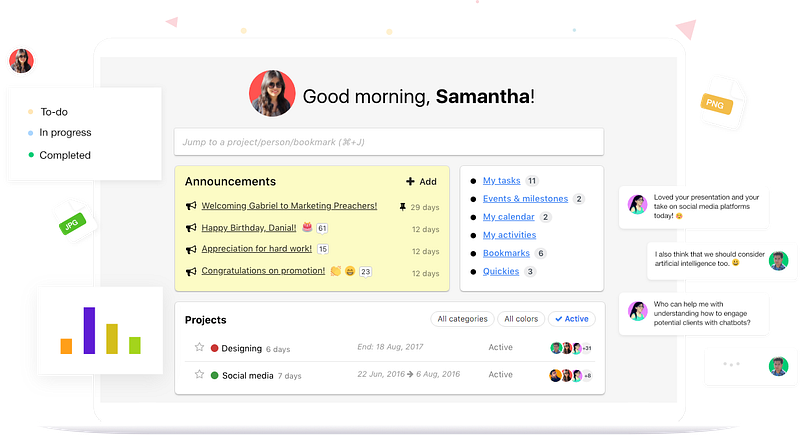
ProofHub is another all-in-one Asana alternative that offers every feature your team will ever need to manage its projects effectively. What’s cool about ProofHub is that it’s not designed with per-user pricing and instead offers fixed pricing plans. You’ll pay the same today with your current team and the same after a year or two when your team is doubled.
Proofhub allows you to easily plan, collaborate, organize and deliver projects regardless of their size without missing deadlines. Proofhub has every feature you need in one place, making your team collaboration and project management as easy as ABC.
Features:
- Kanban boards.
- Gantt charts.
- Custom workflows.
- Tasks.
- Custom roles.
- Proofing.
- Discussions.
- Chat.
- Mentions.
- Announcements.
- Email-in.
- Calendar.
- Files & docs.
- Project templates.
- Notes.
- Request forms.
- File version control.
- Reports.
- Workload report.
- Timesheets.
- Project overview.
- Progress reports.
- Daily agenda.
- White-labeling.
- Notifications.
- API access.
- Activity logs.
- Bookmarks.
- Integrations.
Pros:
- ProofHub features incredible collaboration tools for enhancing your team communication so you can bring everybody on the same page to ensure that every deadline is being met.
- ProofHub also allows you to track the progress being made so you can clearly see what improvements can be made to accelerate your deliverables.
- The interface is pretty simple and easy to use.
Cons:
- Some users would like to see more app integrations.
- At first, you may find it challenging to adapt to ProofHub’s robustness in terms of features, but after a while, you’ll get the sense of it.
- Before creating any task, you should first create a list.
“The ways that ProofHub enables collaboration allow us to set our priorities, instead of the software making us work around its limitation.s Carrier pigeons are expensive and very unreliable. Thank the stars for ProofHub.”
Freedcamp
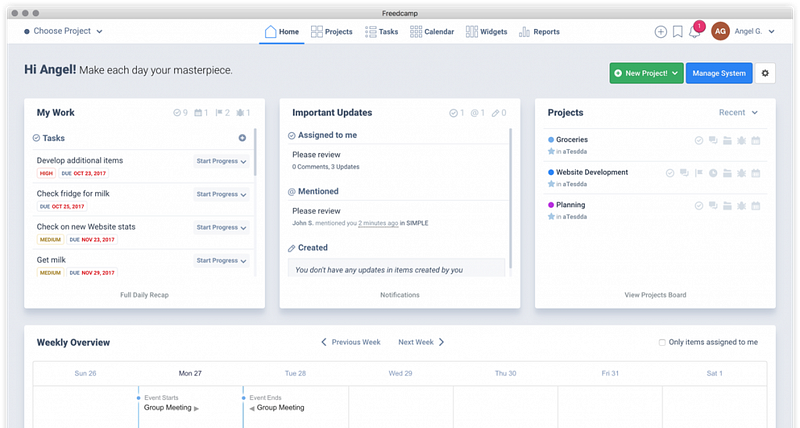
If you feel like your team is out of place, then you’d definitely find Freedcamp to be the app to bring your team on the same page again. Freedcamp can perfectly adjust either to your personal or business projects.
It boasts tons of features so you won’t feel the heavy need to use other 3rd party tools, which can sometimes be detrimental to your productivity.
Features:
- Task lists.
- Kanban boards.
- Subtasks.
- Gantt charts.
- Private tasks.
- Calendar.
- Events.
- Milestones.
- Discussions.
- Wikis.
- Issue tracker.
- Time tracking.
- Passwords.
- Invoices.
- Project templates.
- CRM.
- Backups.
- Widget board.
- White label.
- Files.
- File edit.
- Freedcamp android app.
- 3rd party integrations.
Pros:
- The support team can be easily rated with 5 stars. It’s prompt, consistent, and goes out of its way to help you solve your problems at cat’s speed.
- What’s cool is that although Freedcamp offers tons of features at your disposal, the interface is still relatively easy to adapt to. You won’t be subjected to any headaches in attempts to get the whole picture.
- Freedcamp pricing plans are super affordable compared to Asana costs, starting at $2.45 per user per month. (It also has a free version.)
Cons:
- There’s a steep learning curve, and it’ll require some time to get used to the tool.
- Some users are raving about mass-edit features that allow them to edit something present in all tasks at once instead of having to go through each assignment separately.
- Saving uploaded images can be quite a complicated process, especially when you are using the mobile app.
“Freedcamp is my favorite collaboration tool, it can really handle anything and remain extremely simple and intuitive. It’s my go-to for work or home projects.”
YouTrack

YouTrack is a perfect Asana alternative, especially for dev teams that adhere to Agile methodologies.
It’s relatively flexible and can be easily adapted to your work methods without any hassle at all.
With YouTrack, you’ll have the chance to track tasks and bugs, plan sprints and releases, and assemble workflows while customizing YouTrack specifically for your projects.
As YouTrack relies on Agile methods, it provides Agile boards that can be used either for Kanban, Scrum or mixed frameworks.
What’s more, planning happens easily inside YouTrack because of its flexible backlog. You can create user stories, feature requests and tasks quite effortlessly.
The cool thing about the Agile boards is that they allow you to add swimlanes based on user stories, epics, and deadlines. You’ll know how to handle unexpected difficulties in the best way possible.
Moreover, YouTrack provides you with reports based on your team performance and projects. You can see how your issues are distributed over the projects, assignees, and priorities.
Features:
- Dashboards.
- Reports
- Markdown notes.
- Issue lists.
- Widgets.
- Time reports.
- Gantt charts.
- Documentation and personal notes.
- Knowledge bases.
- Checklists.
- Custom issues.
- Adopt ready to use workflows.
- Choose your language.
- Importer to YouTrack from various other trackers.
- Developer-focused.
- Link issues with code reviews.
- Kanban and Scrum boards.
- Time management.
- Powerful reporting and analytics.
- Customize your workflows.
- Embed image previews in comments.
- Mailbox integrations.
- Integrate with Zendesk.
- Smart search.
- Commands and shortcut support.
- Timesheets.
- Keep your fingers on your team’s pulse with a live dashboard.
Pros:
- YouTrack provides you with super robust reports that give you valuable insights into your performance and progress that you can share with your team.
- It’s relatively easy to start using YouTrack. There are no steep learning curves involved in the process, and you can hit the ground running pretty much instantly.
- In YouTrack, you can change issues’ states from open to fixed easily.
Cons:
- If you are not a tech person, you may find YouTrack tricky and sometimes difficult to search for a particular logged issue.
- It still has some bugs in the UX that may cause some discomfort. Nothing big tho.
- Compared to Jira, YouTrack lacks integrations. Users would definitely love to see more integrations from YouTrack.
“Really enjoying using @youtrack from Jetbrains, ❤ all the inline editing and the command dialog is so handy.”
Quip
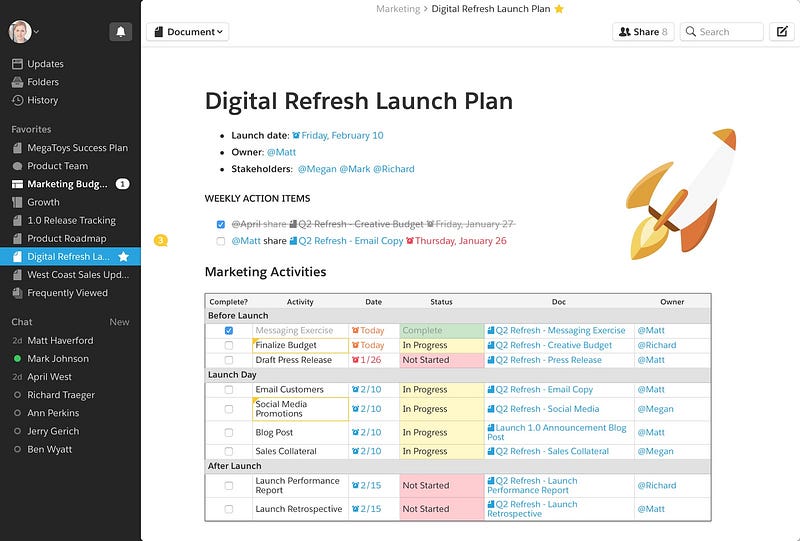
Quip is a fantastic alternative to Asana. It unites your team’s work and communication so you can sync with your team and get more done in less time.
Quip boasts tons of great features like documents, spreadsheets, slides for engagement & feedback, chat rooms, templates and more. With Quip, you’ll rarely feel like you are losing your touch for project management.
Quip allows you to closely surveil the team’s progress so you can improve your work methods and stay on top of your game.
Features:
- Docs.
- Spreadsheets.
- Slides.
- Chat.
- Mobile Ready.
- Offline Mode.
- Permissions.
- Version History.
- Collaborative editing.
- Embed in docs.
- Real-time co-editing.
- Feedback polls.
- Comments.
- 1-on-1 chat.
- Team chat rooms.
Pros:
- What’s cool about Quip is that it’s an effective Asana project management alternative that allows you to create both documents and spreadsheets.
- Importing and exporting documents from and to Quip is made easy. No tedious operations are required.
- With Quip, you’ll be able to bring your team on the same page through Quip’s built-in and intuitive chat rooms.
Cons:
- A downside we’ve noticed here is the pricing options. Compared to other alternatives on this list, Quip appears to be a bit pricey.
- Loading PDF files may take a while as documents typically take a long time to get visualization straight.
- Some users would relish Quip mobile apps if they were available.
“The amount of integrated functionality within Quip really makes it a one tool solution for managing all of your notes, spreadsheets (for simple purposes) within a team or for yourself.”
Bitrix24
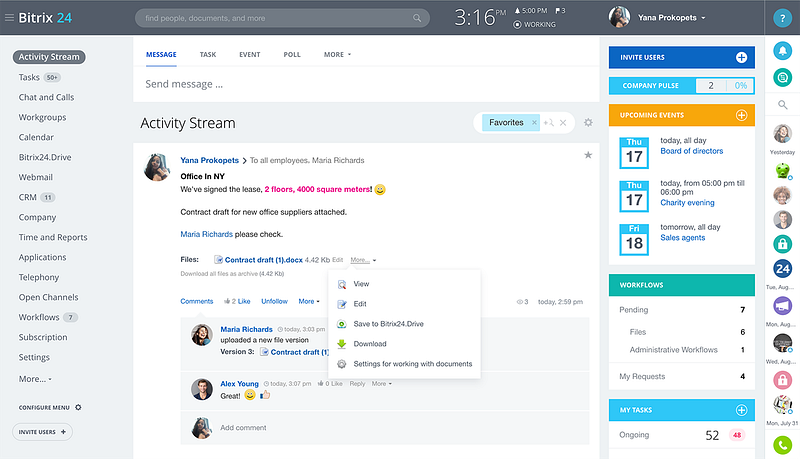
Whether you are a developer, marketer, analyst, or a designer, Bitrix24 has something to offer to everybody.
Bitrix24 is designed with heaps of features that make your project management process much easier.
The cool thing about Bitrix24 is that it has a free version. And you get unlimited projects and unlimited users on board allowing you to try Bitrix24 fully alongside your team without risking a single penny.
You can create tasks, subtasks, insert templates and spread assignments across your team relatively easily inside Bitrix24.
You’ll have the opportunity to bring your team on the same page with effective collaboration tools (chat or video) so that everybody sees the next steps that need to be taken.
Features:
- Kanban boards.
- Gantt charts.
- Subtasks.
- Customizable templates.
- Time tracking.
- Task roles.
- Task reports.
- Calendar sharing.
- CRM.
- CRM reports.
- Daily planner.
- Instant messages.
- Project groups.
- Email notifications.
- Task reporting.
- File sharing and versioning.
- Supervisor views.
- It does offer a free plan.
Pros:
- Bitrix24 brings tons of features to the table, allowing you to manage your projects within one app without the desperate need to subscribe to 3rd party tools.
- Making accurate time and cost estimates inside Bitrix24 is quite easy as the platform delivers quite robust reports. Bitrix24 gives you insights into your team performance and the project’s progress.
- Bitrix24 comes with a feature named Company Pulse that easily identifies team members struggling with their assigned tasks. What’s more, it delivers gamification tools to stimulate your team to work more efficiently and achieve better results.
Cons:
- Some users are complaining about losing their data due to inactivity for a set period.
- There’s a steep learning curve that will require some time from you to get used to it.
“It is a unified platform that encourages collaborative use through the Activity Stream, wherein each member added in the team can track tasks, their progress and update any issues highlighted.”
Mavenlink
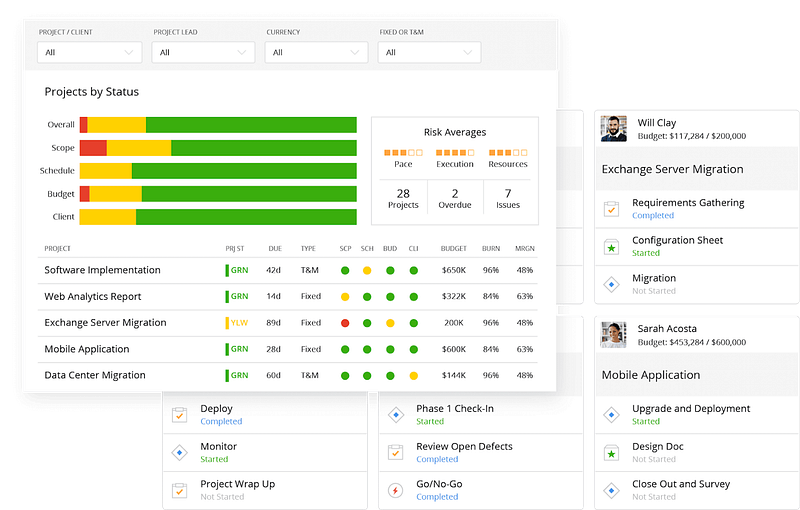
Similar to Bitrix24, Mavenlink is an all-in-one Asana alternative that offers something for everybody regardless of your job title. Mavenlink combines resource management, project management, collaboration, time tracking and project financials in one app, so you don’t have to pay for various 3rd party apps at the end of each month.
The main aspect of Mavenlink is the detailed reports it gives you access to. You’ll get insights into your team performance and progress to make better decisions that can either make or break your project’s success.
Features:
- Task management.
- Time tracking.
- Documentation.
- Campaign management.
- 24/7 support.
- Collaboration tools.
- Email integration.
- Gantt charts.
- Custom branding.
- Time tracking.
- WIP limits.
- Invoicing.
- SSL security.
- File sharing.
- You can try it for free and see for yourself if it fits your team needs.
Pros:
- What makes Mavenlink stand out is its incredible “tracking” features that closely monitor your team’s progress so you can make better time and cost estimates to never miss a deadline again.
- The reports and statistics you are getting from Mavenlink will help you plan your future projects to ensure bigger successes.
Cons:
- The thing that most users complain about is the clunky UI of Mavenlink. You may have a hard time organizing, prioritizing, and spreading tasks across your team, especially if you haven’t used Mavenlink before.
- The learning curve is steep. You may face some challenges initially.
“It’s a little clunky in that there are so many places to put information, and too many ways to do it that make things more disorganized than not.”
LiquidPlanner

LiquidPlanner is another great Asana alternative that allows you to stay one step ahead of the curve by enabling you to plan, prioritize, track, and assess your tasks and projects all in one place.
LiquidPlanner is the only project management solution that has an automated scheduling and forecasting engine. This engine has a proprietary algorithm that calculates when your projects are expected to start and finish, and that automatically recalculates to adapt to change.
LiquidPlanner is designed flexibly to fit your workflow regardless of the changing environment. LiquidPlanner can actually be the only tool that can keep your mind at peace no matter the changes in your work environment.
With LiquidPlanner, you can see your teammates’ work situations at a glance. You’ll know whether your team members are about to burn out. To avoid burn-out, you can regulate their workflow inside LiquidPlanner easily.
The cool thing about LiquidPlanner is that it helps you clearly visualize your tasks, progress, risks, and budgets for your projects. You’ll get insights into how your team performs over time and adjust your work methods if necessary.
Moreover, you can use drag and drop to effortlessly organize your projects and tasks to boost your productivity.
Features:
- Project- and task-level priorities.
- Estimated ranges.
- Automated resource-leveling.
- Smarter time tracking.
- Card view.
- Baseline.
- Powerful dashboards.
- Advanced analytics.
- Project costing.
- Estimates.
- Resource workload report.
- Budgets.
- Drag and drop prioritization.
- Dependencies.
- Risks.
- Super flexible.
Pros:
- LiquidPlanner is effortless to use. You can easily create, define, and prioritize your tasks.
- The UI is simply designed allowing you to avoid any possible frustration and overwhelm from chaotic workspaces.
- LiquidPlanner’s support team is absolutely stunning. They are willing to go out of their way to make sure you get the most pleasant user experience.
Cons:
- The features of access restrictions can be quite limited. You can only put projects in read-only mode.
- There’s a bit of a steep learning curve. It may require you to invest some time initially to get the whole picture.
- Some users have complained about task links taking you away from LiquidPlanner and loading a new page in the same browser tab.
“In a 24-hour period, we moved the project from being over-budget and over-schedule to on-time. This was a small-scale project, and the ROI was 30 percent of the project budget. LiquidPlanner paid for its entire licensing fee in one day.”
nTask
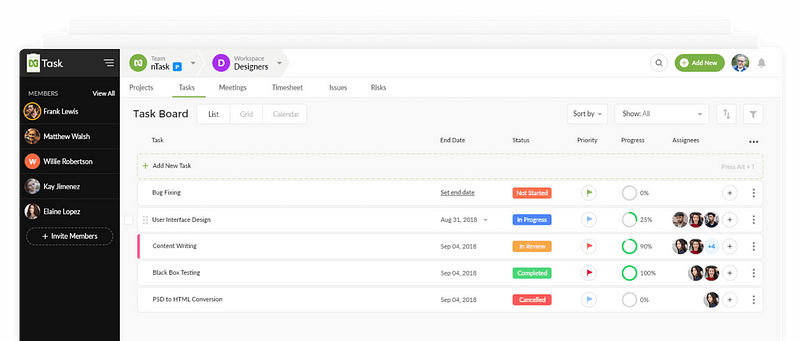
If you are looking for a free Asana alternative that can help you meet all of your deadlines, nTask can be an excellent pick.
nTask boasts Gantt charts to help you visualize project plans and manage your projects much easier than ever. You can create, assign, and prioritize tasks in one place pretty much without any hassle — no need to bounce between tedious 3rd party tools.
By using nTask’s calendar, you’ll be able to stay ahead of the curve and always know what follows.
Moreover, you’ll have the chance to bring your team on the same page through task comments.
With task dependencies, you can link tasks based on their relationship, meaning — Start to Start, Start to Finish, Finish to Start, or Finish to Finish. You can also set project milestones to keep everybody stimulated to work harder.
Features:
- Advanced filters.
- Smart search.
- Interactive Gantt charts.
- Calendar planner.
- Integration with Zapier.
- One-click CSV import & export.
- Time tracking.
- Risk management.
- Issue management.
- Kanban board.
- Meeting management.
- Timeline.
- Time estimates.
- Task dependencies.
- Multiple assignees.
- Recurring tasks.
- Activity log.
- Comments attachments.
- Slash commands.
- Color labeling.
- Custom status.
- Budgeting.
- Role management and permissions.
- Reminders and notifications.
Pros:
- Organizing tasks and managing data inside LiquidPlanner happens without any hassle whatsoever.
- The built-in time tracking feature comes with cost-to-completion tracking.
- The task board offers three ways to visualize your projects clearly. Hence, you always know the next essential steps that need to be taken — list, grid, and calendar.
Cons:
- More integrations can be added.
- There’s a short learning curve that you’ll need to overcome initially.
- Some users think that the calendar task board view isn’t robust enough. The layouts seem to be outdated, and creating reports can be quite hard.
“I am very satisfied about using nTask, because I can work very well with my team, and very important, I can manage all the situations that we have in our company, and we can easy solve them!”
Comidor

Comidor is an excellent business process modeling and execution tool.
It centralizes and automates all the processes and it improves communications internally. Comidor comes with added modules like Project management, HRM, CRM , and more.
Large corporations, in the sectors of pharma, telecom, chemicals, logistics, energy and others, trust Comidor, to automate their core processes and have a critical impact on their bottom line and customer experience.
The cool thing about Comidor is:
- Intelligent Automation combines BPM with Advanced Workflows, RPA and AI/ML to orchestrate, automate and improve business processes.
- Enterprise Low-Code empowers business users to design, build and deliver complete business apps, with low to no coding.
- Enterprise Architecture enables enterprise architects to analyze, design, plan and implement the business strategy.
- Digital Workplace creates a digital business environment where people and robots successfully complete tasks and processes.
Features:
- Task Management.
- Personal and team interactive Calendars.
- Complete to-do dashboards.
- Customized Timesheets.
- Workload management.
- Event management.
- Email integration.
- Internal and instant messaging.
- Smart notifications.
- News and alerts.
- Text Chat and Video Conferencing.
- Account and Contact management.
- Access rights based on user/team/role.
- Files and Document management.
- All file operations available.
- Version management.
- Link with any Comidor record.
- Link with any Comidor process.
- Notes.
- Comments and embedded Wikis.
Pros:
- Comidor offers innovative project management solutions that are second to none.
- It’s perfectly suitable for large teams and corporations. It features tons of automations that will help you avoid doing tedious tasks manually.
- It is designed with tons of features meaning you won’t need to subscribe and spend money on other 3rd party apps.
Cons:
- The interface can be a bit clunky due to the vast amount of features Comidor brings to the table. There might be a bit of a learning curve you’ll need to overcome initially.
- It’s kinda limited in integrations.
“Comidor is a great Collaboration Platform. We were searching for that kind of software for a long time! We have been testing the product since July 2016 and using it productively since October 2016. Full Featured for our needs, adding more features with the help of Comidor Team. Great response time, perfect collaboration with all the personnel and developers! Cost-effective, indeed!”
Kissflow

Kissflow Project is another great Asana alternative that lets you customize your entire workflow so you can manage projects easily instead of conforming to the tool’s working.
Kissflow is ideal for functional teams such as marketing and sales. It ties together powerful features along with intuitiveness, making it a comprehensive project management suite.
What’s more, it features Kanban boards, list views, swim lanes, and pivot tables to help you clearly visualize the following steps of your project. You can also break down tasks into smaller chunks so you can complete incremental steps at a time.
Features:
- Custom forms: 20+ drag-and-drop fields to meet your unique requirements.
- Task states: Use in-progress, hold, and done states to reflect the number of work-in-progress items accurately.
- Multiple views.
- Subtasks.
- Project templates.
- Kanban boards.
- Hold/Done.
- Time tracking.
- Alerts and notifications.
- File sharing.
- Activity stream.
- Reports: Powerful reports like burndown charts, velocity, and lead time help make data-driven decisions
Pros:
- Kissflow can help you manage your projects much easier because of its simple UI/UX. You won’t feel overcome with frustration that makes you wanna smack your head against the wall in your office.
- Moreover, Kissflow can bring your team on the same page through comments on cards, feedback reviews, mentions, and team chat.
- It boasts a forever-free plan for up to 10 users. You can fully try Kissflow along with your team and see if it suits you without risking a penny.
Cons:
- There’s a lack of clarity regarding the API integration in their documentation.
- Even though it has a free plan for smaller teams, it can become pricey for larger organizations.
- There are no Gantt charts available.
“My experience with Kissflow has been truly defining. I am able to collaborate with members of other departments without moving away from my desks.”
Podio

Podio is a great Asana alternative that allows you to fully customize your workflow without any hassle whatsoever.
With Podio, you can get your team on the same page by adding task comments to ease the communication between your teammates.
What’s more, Podio allows you to control the access to your workspaces through granular admin capabilities.
Moreover, you can bring clients, freelancers and other external members into Podio for zero charges to avoid the overwhelming amount of ugly-designed email threads and time-consuming file sharing.
Features:
- Boards.
- Tasks.
- Web & mobile.
- Automated workflows.
- Meeting scheduling.
- Data visualization.
- Social collaboration.
- Task management.
- Granular access.
- Calendar.
- Unlimited storage.
- Personal dashboard.
- Connected CRM.
- Project management.
- Integrated chat.
- Full customization.
- Integrations.
- Real, human support.
- File sharing.
- Podio API.
- Extensions.
- Feature index.
Pros:
- Podio’s simply-designed UI is both elegant and simple to understand. You won’t have any trouble navigating your way through Podio.
- With Podio, you’ll have the chance to bring your team on the same and thus meet all of your deadlines.
- Sharing files easily across various platforms happens easily with Podio.
Cons:
- The notifications features can be improved as some alerts are lacking.
- Some users complain that the “emails to task” feature is kinda limited. It needs further modifications in terms of building content.
- Attaching files can also be kinda hard.
“It is one of the most effective platforms that provide efficient services for managing projects. I really appreciate its services and performance.”
